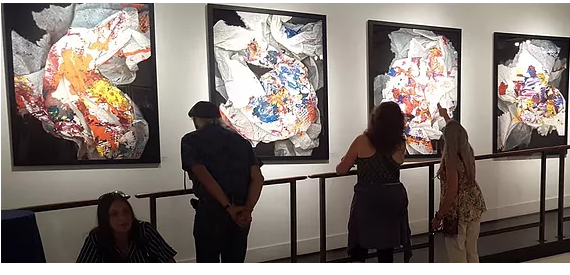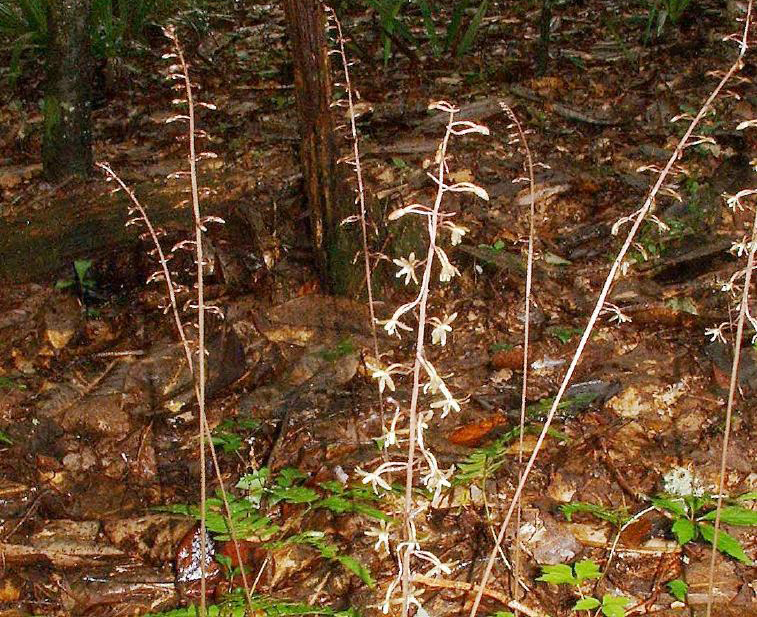
What every parent needs to know about COVID-19 before school begins
August 30, 2021
Upcoming Artist Workshop at Monmouth Museum
August 30, 2021 The State We’re In by Michele S. Byers, Executive Director, New Jersey Conservation Foundation – Leaves of green stand out in a drab winter landscape, when nearly everything else is gray or brown. That’s how a cranefly orchid was discovered a few years ago at a preserved farm in Salem County.
The State We’re In by Michele S. Byers, Executive Director, New Jersey Conservation Foundation – Leaves of green stand out in a drab winter landscape, when nearly everything else is gray or brown. That’s how a cranefly orchid was discovered a few years ago at a preserved farm in Salem County.
Scott Breeman, easement steward for New Jersey Conservation Foundation, spotted the leaves and thought they could be from an orchid. Intrigued, the landowner fenced the area to protect the plants from deer. The efforts paid off this summer when dozens of stalks emerged from the ground with pale greenish-yellow, cranefly-shaped flowers.
Cranefly orchids are different from most plants in that they don’t have flowers and leaves at the same time. Each autumn, a single green leaf with a purple underside emerges from the ground and stays through spring, enjoying a long season alone without competition for sunlight. If the plant can store enough energy, it will put up a flower stalk in mid to late summer, with irregular-shaped blooms resembling long-legged insects.
Cranefly orchids are just one of New Jersey’s many wild orchids. If you think of orchids as cultivated hothouse flowers you might be surprised to learn that the Garden State is home to over 50 native species!
How did New Jersey get so many wild orchids? As real estate agents say – location, location, location.
New Jersey is in an ecological sweet spot, at the northern end of the range for southern plant and animal species, and at the southern end of the range for northern species. In addition to these overlapping ranges, this state we’re in has a wide variety of habitats, from mountains to beaches and everything in between.
“A lot of our orchids might be extremely rare for us, but quite common from a global perspective,” noted Russell Juelg, Senior Land Steward for New Jersey Conservation Foundation.
 While it might take sharp eyes to spot inconspicuous-looking cranefly orchid flowers, many of New Jersey’s wild orchids are bright and showy.
While it might take sharp eyes to spot inconspicuous-looking cranefly orchid flowers, many of New Jersey’s wild orchids are bright and showy.
Some of the prettiest include the white-fringed, yellow-fringed and purple-fringed orchids, along with rose pogonia, dragon’s mouth, and pink, yellow and white lady’s slipper orchids.
New Jersey’s rarest orchid is the small whorled pogonia, a federally-listed threatened species and state-listed endangered species. Small whorled pogonia populations have been confirmed in only three locations in northern New Jersey.
While native orchids are a delight to discover, please resist the urge to pick them for a wildflower bouquet or dig them up for transplant.
“It’s very important to leave them in the wild,” emphasized Russell. “Take photos, don’t pick them.”
He warned that many populations of native orchids have been depleted in the past by collectors who wanted to grow them in their own gardens. Most were unsuccessful.
“Wild orchids are notoriously hard to grow,” said Russell. “They’re very well adapted to specific habitats, and don’t do well at all when you try to propagate them away from their natural habitat.”
Unlike some cultivated tropical orchids, which grow on other plants instead of in soil, New Jersey’s wild orchids are terrestrial. They are dependent on soil, including the “mycorrhizal” community within the soil. “What this means is they have a close and essential connection with the fungi in the soil,” explained Russell. “Without that fungi, they cannot survive.”
 And did you know that some orchids go for years without flowering. They might seem like they’re gone, because they put out only a single leaf a year. But once they store up enough energy through photosynthesis, they can bloom in profusion.
And did you know that some orchids go for years without flowering. They might seem like they’re gone, because they put out only a single leaf a year. But once they store up enough energy through photosynthesis, they can bloom in profusion.
While the recently-discovered cranefly orchid population in Salem County is rare for New Jersey, globally the plant is doing well. Its status was recently upgraded from “vulnerable” to “apparently secure.”
“It’s an example of how we’ve succeeded in preserving enough habitat that we don’t have to worry as much about them as we did in the past,” said Russell. But this is not necessarily true for other native orchids … or for New Jersey native plants in general.
Major threats to native orchids and other wildflowers include overabundant deer browsing, the spread of invasive plant species, poaching, and off-road vehicle drivers that destroy habitat. Loss of habitat and habitat fragmentation are also serious threats, compounded by destructive management practices and aggressive logging that overlooks the importance and needs of rare plants.
It is critical for New Jersey to preserve land with a variety of habitats, and prevent poaching and damage from off-road vehicles. Let’s make sure our native wild orchids will be around for future generations of nature lovers to enjoy!
To see photos of New Jersey’s wild orchids, go to the website www.pbase.com/ngannet/native_orchids&page=all.
If you’re interested in learning more about these incredible plants, consider a field guide like Paul Martin Brown’s Wild Orchids of the Northeast. You can purchase a copy at https://upf.com/book.asp?id=9780813030340
And for information about preserving New Jersey’s land and natural resources – including habitat for orchids and other native wildflowers – visit the New Jersey Conservation Foundation website at www.njconservation.org or contact me at info@njconservation.org.






